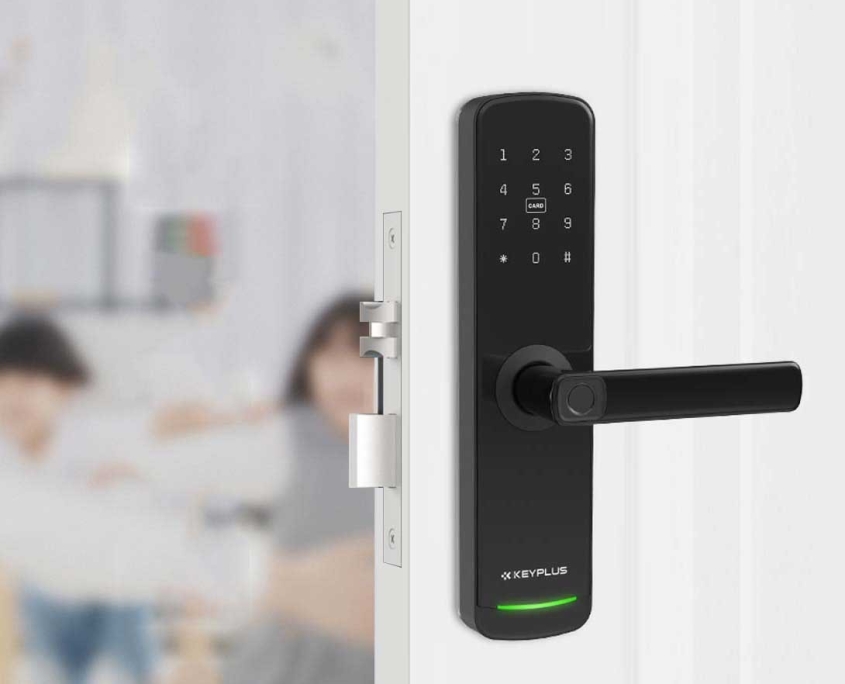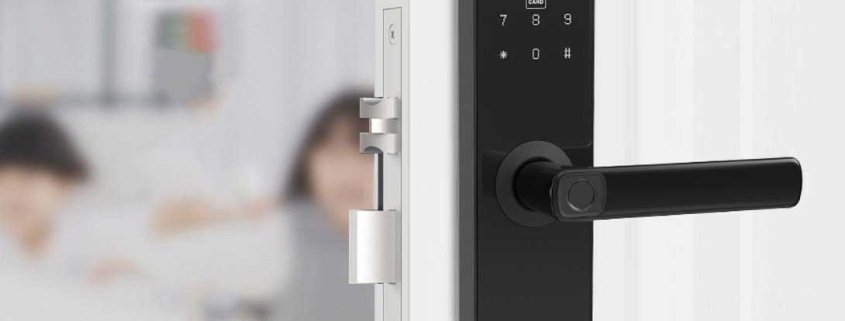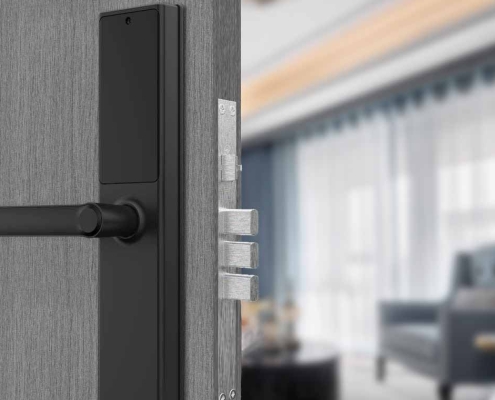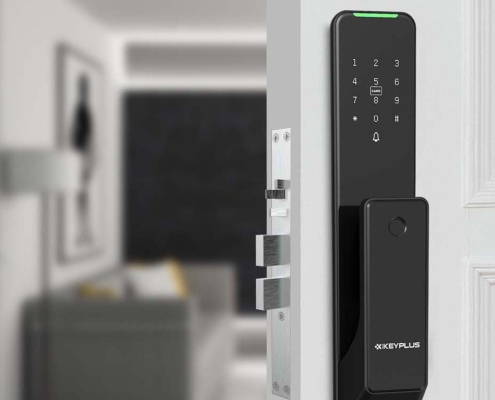What is the difference between smart lock and electronic lock?
In today’s increasingly connected world, home security has evolved far beyond traditional mechanical locks. As Americans seek more convenient and sophisticated ways to protect their homes, the choice between smart locks and electronic locks has become a common dilemma. While both represent advancements over conventional keyed locks, they serve different needs and offer distinct features. This comprehensive guide will explore the key differences between these two types of modern locking systems, helping you make an informed decision for your home security needs.
Understanding Electronic Locks
What Exactly Is an Electronic Lock?
Electronic locks represent the first generation of digital locking technology. These devices replace traditional keys with electronic access methods while maintaining a relatively simple design compared to their smarter counterparts. The fundamental characteristic of electronic locks is their self-contained operation—they don’t connect to your home network or other smart devices.
Key Features of Electronic Locks
-
Keyless Entry Systems: Most electronic locks use numeric keypads, RFID cards, or fobs instead of physical keys.
-
Battery-Powered Operation: They typically run on replaceable batteries (usually AA) that last several months to a year.
-
Manual Control: All programming and operation happens directly at the lock itself.
-
No Internet Connectivity: These locks function as standalone devices without Wi-Fi, Bluetooth, or other wireless capabilities.
-
Basic Access Logs: Some models can record when codes are used to unlock the door, but this data stays on the device.
Common Types of Electronic Locks
-
Keypad Locks: Require users to enter a numeric code to unlock
-
Card/Fob Access Locks: Use RFID technology similar to hotel key cards (e.g., SALTO systems)
-
Biometric Locks: Incorporate fingerprint scanners for access
Pros of Electronic Locks
-
Simplicity: Easy to install and use with minimal setup required
-
Reliability: Fewer components mean fewer potential points of failure
-
No Network Dependency: Can’t be hacked remotely since they’re not connected
-
Cost-Effective: Generally more affordable than smart locks (typically 100−250)
-
Long Battery Life: Often lasts longer than smart locks due to limited functionality
Cons of Electronic Locks
-
Limited Features: Lack advanced capabilities like remote access
-
No Remote Management: Must be physically present to change codes or settings
-
Basic Security: Some models may be vulnerable to code guessing or physical tampering
-
No Integration: Can’t work with other smart home systems
Exploring Smart Locks
Defining Smart Locks
Smart locks take electronic locking technology several steps further by incorporating connectivity and advanced features. These devices are designed to integrate with your home automation ecosystem and provide remote access capabilities. What truly makes a lock “smart” is its ability to connect to your smartphone and/or home network, enabling features that go beyond basic keyless entry.
Key Features of Smart Locks
-
Wireless Connectivity: Utilize Wi-Fi, Bluetooth, Z-Wave, or Zigbee to connect to networks
-
Remote Access: Can be controlled from anywhere via smartphone apps
-
Voice Control: Compatible with assistants like Alexa, Google Assistant, or Siri
-
Advanced User Management: Create and revoke access permissions digitally
-
Real-Time Notifications: Receive alerts when the lock is used
-
Integration Capabilities: Work with other smart home devices (e.g., lights, security cameras)
-
Auto-Locking: Can automatically lock after a set period or when you leave
Common Smart Lock Types
-
Wi-Fi Enabled Locks: Directly connect to home networks
-
Bluetooth Locks: Pair with nearby smartphones
-
Z-Wave/Zigbee Locks: Integrate with smart home hubs
-
Keypad Combo Locks: Offer both smart features and physical keypad
Advantages of Smart Locks
-
Convenience: Lock/unlock doors remotely for family, friends, or service providers
-
Temporary Access: Grant time-limited access without sharing permanent codes
-
Enhanced Security Features: Many include tamper alerts and forced entry detection
-
Seamless Integration: Works with other smart devices for automation (e.g., lights turn on when unlocked)
-
No More Lost Keys: Eliminate the need for physical keys altogether
-
Activity Monitoring: Track who comes and goes with detailed access logs
Disadvantages of Smart Locks
-
Higher Cost: Typically range from 150−400 for quality models
-
Network Dependence: Require stable Wi-Fi or hub connections for full functionality
-
Security Concerns: Potential vulnerability to hacking (though rare with proper setup)
-
Shorter Battery Life: More features drain batteries faster (usually 3-6 months)
-
Complexity: Some users find setup and troubleshooting challenging
-
Privacy Considerations: Data collection by manufacturers may concern some users
Key Differences Between Smart and Electronic Locks
1. Connectivity and Remote Access
The most fundamental difference lies in connectivity. Electronic locks operate as independent devices, while smart locks connect to your home network and smartphone. This means with a smart lock, you can check if your door is locked while at work or let in a house cleaner remotely. Electronic locks require physical presence for any interaction.
2. User Management Capabilities
Smart locks offer sophisticated user management. You can create unique access codes or digital keys for family members, assign specific access times (great for cleaning services or dog walkers), and revoke access instantly. Electronic locks typically have limited code management—often just a few static codes that must be changed manually at the lock.
3. Integration with Other Systems
Only smart locks can participate in home automation scenarios. For example, your smart lock can trigger your security system to disarm when you unlock the door, or turn on hallway lights when you arrive home after dark. Electronic locks function in isolation from other home systems.
4. Installation and Compatibility
Many electronic locks are designed as complete door handle or deadbolt replacements, often easier to install for DIYers. Smart locks come in various forms—some replace entire deadbolts, while others attach to existing hardware. Compatibility with existing doors varies more with smart locks.
5. Security Considerations
While both are generally secure, their vulnerabilities differ. Electronic locks may be susceptible to code observation or physical tampering. Smart locks could theoretically be hacked (though major brands use strong encryption), but offer features like instant tamper alerts that electronic locks lack.
6. Power Requirements
Both types use batteries, but smart locks typically consume power faster due to their wireless radios and additional features. Some high-end smart locks offer backup power options or emergency charging ports that most electronic locks lack.
7. Cost Structure
Electronic locks have a lower upfront cost and no ongoing fees. Smart locks may require additional investments like a smart home hub or subscription for advanced features (though many work fine without these).

Which Should You Choose?
When an Electronic Lock Makes Sense
-
For Rental Properties: Easy to install and change codes between tenants without complex setup
-
For Tech-Wary Users: Those uncomfortable with connected devices or app management
-
Secondary Entrances: On doors where advanced features aren’t necessary
-
Budget-Conscious Buyers: Quality electronic locks cost significantly less
-
Areas with Poor Wi-Fi: Where network connectivity would be unreliable
When a Smart Lock Is the Better Option
-
Primary Entry Doors: Where you want maximum control and convenience
-
Frequent Guest Access: If you regularly need to grant temporary access
-
Smart Home Enthusiasts: For integration with other automated systems
-
Families with Older Kids: Allows flexible access without distributing keys
-
Frequent Travelers: Remote access provides peace of mind while away
Installation Considerations
Regardless of which type you choose, proper installation is crucial:
-
Measure Existing Hardware: Ensure compatibility with your door thickness and existing deadbolt
-
Check Door Alignment: Misaligned doors can cause operational issues
-
Consider Professional Installation: Especially for complex smart lock systems
-
Test Thoroughly: Before relying on the lock, verify all features work properly
Maintenance Tips
For Electronic Locks:
-
Change batteries proactively (at least once a year)
-
Clean keypads regularly to prevent buildup
-
Update codes periodically for security
For Smart Locks:
-
Keep firmware updated for security patches
-
Monitor battery levels through the app
-
Check connection status regularly
-
Review access logs periodically
The Future of Digital Locks
As technology advances, the line between electronic and smart locks continues to blur. Emerging trends include:
-
Facial Recognition: Already appearing in some high-end models
-
Voice Activation: More sophisticated than current voice command integration
-
Self-Powering Locks: Using kinetic energy from use to power the device
-
Blockchain Security: For unhackable digital key distribution
Conclusion
The choice between a smart lock and an electronic lock ultimately depends on your specific needs, technical comfort level, and budget. Electronic locks offer simplicity and reliability at an affordable price point, while smart locks provide unparalleled convenience and integration at a higher cost and with greater complexity.
For most American homeowners, smart locks represent the clear future of home security, especially for primary entry points. However, electronic locks still serve important roles in secondary applications or for those who prefer to keep things simple. By understanding the capabilities and limitations of each, you can select the perfect locking solution to keep your home secure in the digital age.
Remember that no lock—smart or otherwise—makes your home completely invulnerable. The best security approach combines quality locks with other measures like security cameras, motion lights, and neighborhood awareness. Whichever lock type you choose, proper use and maintenance will ensure it provides reliable protection for years to come.









